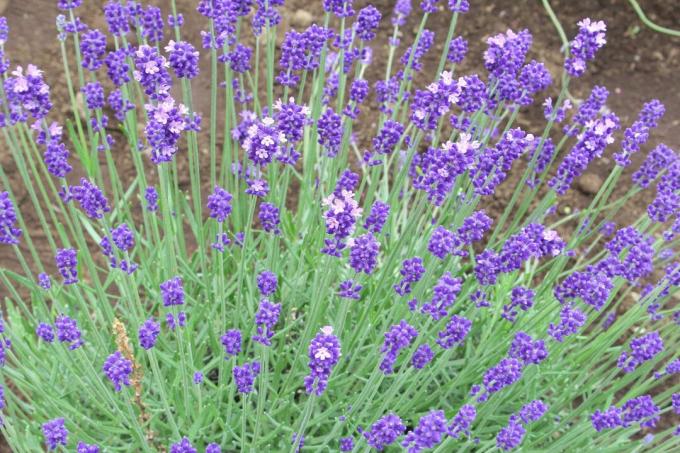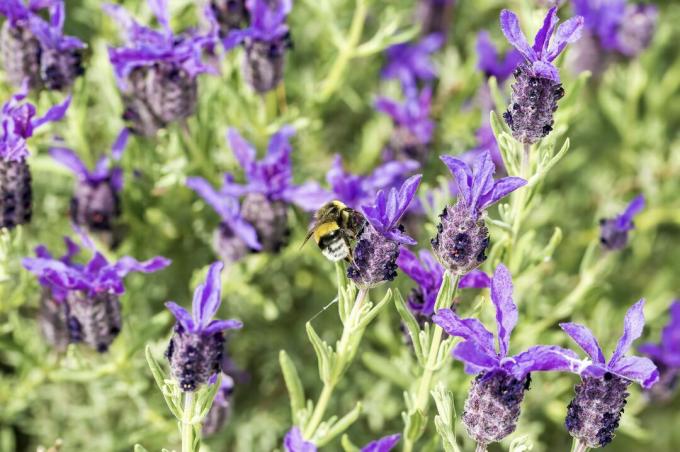True lavender is one of the best-known types of lavender and includes a large number of varieties for every taste. We introduce you to the best.

There are more than 25 known types of lavender, which not only differ in their properties such as their scent and their habit, but also have different winter hardiness. real lavender (Lavandula angustifolia) is particularly popular here because of its tolerance to the winter conditions in our latitudes.
The great variety of varieties of real lavender makes gardeners' hearts beat faster. Whether compact-growing dwarf varieties for pot culture on balconies and terraces or suitable varieties for sprawling Scented hedges in the garden, whether classic lavender blue, radiant white or delicate shades of pink - everyone is sure to be find it.
The original home of lavender is in the coastal regions of the Mediterranean. There it grows on dry and rocky slopes, even at higher altitudes. Therefore, he does not make particularly high demands on his location. A sunny, warm place with a rather nutrient-poor, well-drained soil is ideal for the lavender. Waterlogging, on the other hand, should be avoided at all costs. If you don't have your own garden, you can also cultivate real lavender in pots. Therefore, we present the best varieties for pots and gardens below.
True Lavender: Popular varieties for growing in pots
Real lavender can reach very different sizes. Smaller, compact varieties are particularly suitable for balcony planting. Larger potted plants can also find a place on the terrace or in a parking space in the garden. The following varieties are well suited for pot cultivation:
- ‘Blue Cushion': Compact cultivar with squat spikes and large, durable, light purple flowers; well suited for pot culture or the rock garden; dwarf form.
- ‘Little Lottie': Filigree, soft pink flowers are the hallmark of this dwarf variety.
- ‘Peter Pan': dwarf form with dark violet flower; slow and compact growing.
- ‘Nana Alba': Slow-growing dwarf form with a bushy structure and white flowers.

Real lavender: The most beautiful varieties for the garden
Particularly robust and usually hardy varieties of real lavender are suitable for outdoor cultivation. Depending on the growth form and flowering time, there are various possible uses. We can recommend the following varieties for the garden:
- ‘DwarfBlue': Proven, medium-tall variety with grey-green foliage and violet flowers, which is well suited as a bed border and scented hedge.
- ‘followgate': Particularly early flowering lavender with compact foliage, tall spikes and sapphire blue flowers; very well suited as a low hedge or border for beds.
- ‘Blue Ice': Medium-tall variety with exceptional ice-blue flowers.
- ‘Blue Mountain White': Vigorous lavender with white flowers grows a little taller than the 'Nana Alba' variety.
- ‘Hidcote Blue': Proven variety from England with dark blue-violet flowers and a strong fragrance; compact and slow growing; however, under ideal growing conditions, the plants can grow relatively tall.
- ‘Hidcote Pink': Vigorous growing variety with soft pink flowers; needs regular pruning.
- ‘Imperial Gem': Deep purple-blue flowers that appear profusely and late; very similar to 'Hidcote Blue' but taller in stature; forms a regular hemispherical bush.
- ‘Jamlitz': Robust lavender that can cope well with rough conditions.
- ‘Lumiere des Alpes': Robust variety whose blue-violet flowers show an interesting play of colours; lighter lipped flowers stand out against dark blue calyxes.

- ‘maillette': Violet-flowering variety from Provence, which is used commercially there; stands out due to its high proportion of essential oils, intense fragrance and willingness to bloom.
- ‘Melissa': The blossoms of this lavender show an enchanting play of colours: the delicate pink buds fade to a radiant white as they bloom.
- ‘Melissa Lilac': With its light purple flowers, hairy flower spikes and broad leaves, 'Melissa Lilac' is beautiful to look at, but this variety is particularly sensitive to waterlogging.
- ‘Miss Katherine': This lavender produces the brightest pink of all varieties of true lavender.
- ‘Munstead': A particularly early flowering cultivar from England with midnight blue flowers and attractive silver-grey foliage; spreads an intense scent due to its compact growth; very suitable for bed edging.
- ‘Rêve de Jean-Claude': Variety from Provence with very upright growth and an intense fragrance.
- ‘rosea': An old variety from the 1930s that bears pastel pink flowers.
- ‘Royal Purple': Grows relatively high and is therefore ideal for loosely growing scented hedges; long, upright flower spikes; very suitable for drying.
- ‘siesta': Is characterized by a particularly spicy aroma and is therefore particularly suitable for use in the kitchen.
- ‘Two Seasons‘ / ‘Irene Doyle‘: Repeating variety with bushy growth and light violet flowers; the second flowering begins in autumn.

In general: keep your eyes open lavender purchase. Also the attractive one French lavender with its showy flowers is becoming more and more popular in the trade. In contrast to real lavender, however, it is very sensitive to cold and should therefore be overwintered frost-free.
How one growing French lavender we present to you here in our special article.


